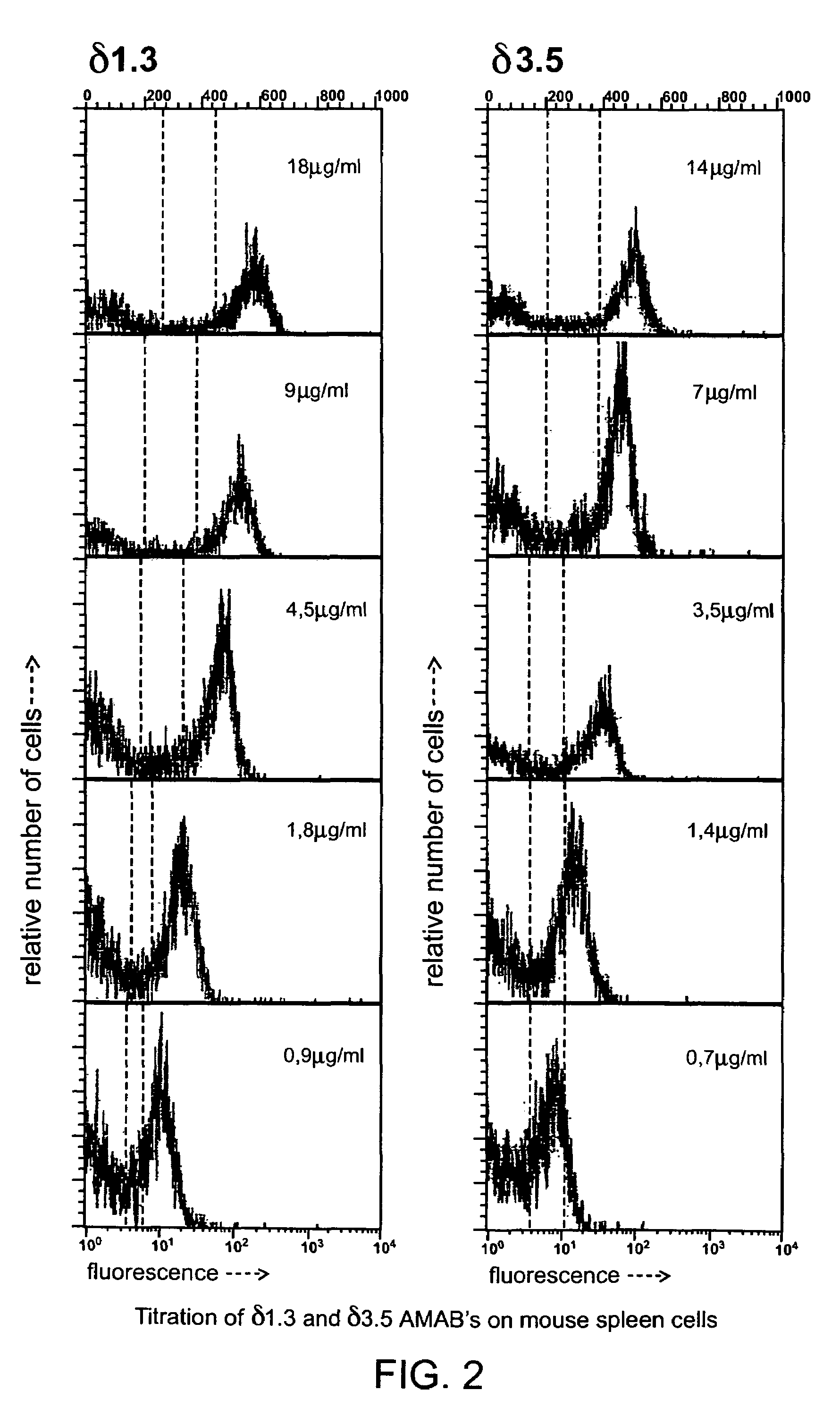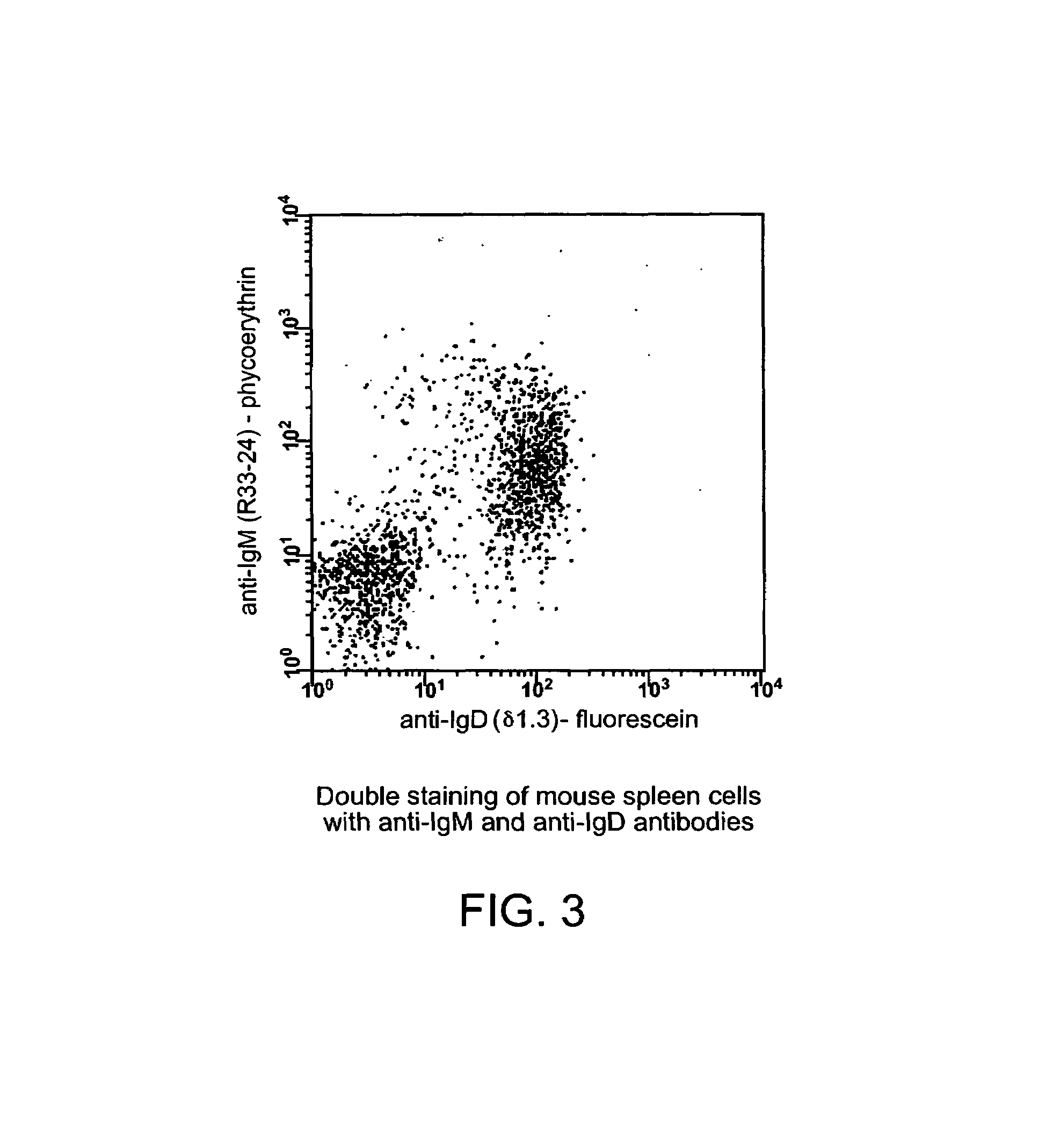Antibodies against epitopes with homology to self antigens, methods of preparation and applications thereof
an antigen and self-antibody technology, applied in the field of antigens against epitopes with homology to self antigens, methods of preparation and application thereof, can solve the problems of inability to artificially manipulate, difficult to generate antibodies to highly conserved domains of proteins, and virtually impossible to obtain antibodies with high affinity to such epitopes
- Summary
- Abstract
- Description
- Claims
- Application Information
AI Technical Summary
Problems solved by technology
Method used
Image
Examples
example 1
Gene Targeting
[0050]Gene targeting of the Cδ gene was performed as described by Roes and Rajewsky (1993) J. Exp. Med. 177:45–55; and Roes and Rajewsky (1991) Int. Immunol. 3:1367–1371. Briefly, a total of 108 E14-1 ES cells were transfected with the targeting vector designed to replace a large part of the Cδ1 exon and to insert frameshift mutations in Cδ3 by filling in restriction sites present in this exon. The introduction of the mutations into the germ-line resulted in functional inactivation of both δ chain Ig domain exons. This was considered important to exclude the possibility of expression of a truncated δH chain that could compete with μ for L chains and be secreted. The presence of the frameshift in the mouse germ-line was indicated by an NheI restriction site resulting from filling in the HindIII site in Cδ3. The Cδ2 exon is a pseudoexon due to a nonfunctional splice acceptor.
[0051]Colonies surviving selection were analyzed by PCR, and positive clones were further analyze...
example 2
Generation of IgD-Deficient Mice
[0052]The generation of IgD-deficient mice was performed as described by Roes and Rajewsky (1993) Briefly, the strategy of Cδ gene inactivation and the screening procedure for positive clones was as described in Example 1. Targeted ES cell clones were injected into blastocysts isolated from C57BL / 6 mice and transferred to (C57BL / 6×BALB / c) fosters. Male chimeric offspring were mated with C57BL / 6 females for germ-line transmission of the δT mutation. Offspring derived from ES cells were identified by coat color and analyzed for the presence of the mutation, which was called δT, by Southern blotting or phenotypically, by flow cytometry. Homozygous mutant mice (δT / δT) were obtained by the interbreeding of heterozygous offspring.
example 3
Northern Blot Analysis of Putative (δT / δT) Mutant Mice
[0053]The northern blot analysis of putative (δT / δT) mutant mice was performed as described by Roes and Rajewsky (1993). Briefly, the δT mutation results in functional inactivation of both exons encoding Ig domains of the H chain. The transmembrane and the hinge region exons, however, remain intact and potentially functional. To exclude the possibility that aberrant splicing of precursor RNA encompassing both the Cμ and the Cδ genes resulted in the generation of a significant amount of chimeric Ig transcripts encoding the extracellular domains of the Cμ gene and the transmembrane and cytoplasmic portion of Cδ, poly(A)+ RNA isolated from spleens of homozygous mutant (δT / δT) and wild-type mice was analyzed by Northern blotting. mRNA containing Cμ exons spliced to the Cδ transmembrane exon would be larger than the normal Cμ transcripts of 2.4 (μs) or 2.7 kb (μm), because the 3′-untranslated region of the δ message is 600-bp longer t...
PUM
| Property | Measurement | Unit |
|---|---|---|
| size | aaaaa | aaaaa |
| size | aaaaa | aaaaa |
| size | aaaaa | aaaaa |
Abstract
Description
Claims
Application Information
 Login to View More
Login to View More - R&D
- Intellectual Property
- Life Sciences
- Materials
- Tech Scout
- Unparalleled Data Quality
- Higher Quality Content
- 60% Fewer Hallucinations
Browse by: Latest US Patents, China's latest patents, Technical Efficacy Thesaurus, Application Domain, Technology Topic, Popular Technical Reports.
© 2025 PatSnap. All rights reserved.Legal|Privacy policy|Modern Slavery Act Transparency Statement|Sitemap|About US| Contact US: help@patsnap.com



